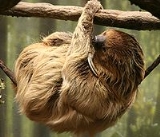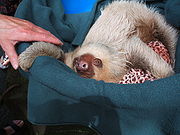
Two-toed sloth
Encyclopedia
Choloepus is a genus
of mammal
s of Central and South America, within the family
Megalonychidae
consisting of two-toed sloths. There are only two species of Choloepus (which name means "lame foot"): Linnaeus's Two-toed Sloth
(Choloepus didactylus) and Hoffmann's Two-toed Sloth
(Choloepus hoffmanni). These two species are the only members of the family Megalonychidae
.
Although similar to the somewhat smaller and generally slower moving three-toed sloth
s (Bradypus), there is not a close relationship between the two genera. Recent phylogenetic analyses support the morphological data from the 1970s and 1980s that the two genera are not closely related and that each adopted their arboreal lifestyles independently. It is unclear what, if any, ground-dwelling sloth taxa the three-toed sloths evolved from; the two-toed sloths appear to nest phylogenetically within one of the divisions of Caribbean megalonychids, and thus probably either descended from them or are part of a clade that invaded the Caribbean multiple times. Both types tend to occupy the same forests: in most areas, a particular single species of three-toed sloth and a single species of the larger two-toed type will jointly predominate.
.
 Two-toed sloths have a gestation
Two-toed sloths have a gestation
period of between six months and a year, depending on the exact species. The mother gives birth to a single young, while hanging up-side down. The young are born with claws, and are weaned
after about a month, although they will remain with the mother for several more months, and do not reach sexual maturity until the age of 3 years, in the case of females, or 4–5 years, in the case of males.
Two-toed sloths spend most of their life hanging from trees, and are generally nocturnal animals. They are somewhat more active than three-toed sloths. Their body temperature depends at least partially on the ambient temperature; they cannot shiver to keep warm, as other mammals do, because of their unusually low metabolic rates and reduced musculature. Two-toed sloths also differ from three-toed in their climbing behaviors, preferring to descend head first.
They eat primarily leaves, but also shoots, fruits, nuts, berries, bark, and occasionally small rodents. They have large stomachs, with multiple chambers, which help to ferment the large amount of plant matter that they eat. Food can take up to a month to digest due to their slow metabolism. Depending on when in the excretion cycle a sloth is weighed, urine and feces may account for up to 30 percent of the animal’s body weight, which averages about 6 kilograms (about 13 pounds). They have a reduced, ever growing dentition
, with no incisor
s or true canines, and which overall lacks homology with the dental formula of other mammals. Their first tooth is very canine-like in shape and is referred to as a caniniform. It is separated from the other teeth, or molariforms, by a diastema
. The dental formula of two-toed sloths is: (unau)
Genus
In biology, a genus is a low-level taxonomic rank used in the biological classification of living and fossil organisms, which is an example of definition by genus and differentia...
of mammal
Mammal
Mammals are members of a class of air-breathing vertebrate animals characterised by the possession of endothermy, hair, three middle ear bones, and mammary glands functional in mothers with young...
s of Central and South America, within the family
Family (biology)
In biological classification, family is* a taxonomic rank. Other well-known ranks are life, domain, kingdom, phylum, class, order, genus, and species, with family fitting between order and genus. As for the other well-known ranks, there is the option of an immediately lower rank, indicated by the...
Megalonychidae
Megalonychidae
Megalonychidae is a group of sloths including the extinct Megalonyx and the living two toed sloths. Megalonychids first appeared in the early Oligocene, about 35 million years ago, in southern Argentina , and spread as far as the Antilles by the early Miocene...
consisting of two-toed sloths. There are only two species of Choloepus (which name means "lame foot"): Linnaeus's Two-toed Sloth
Linnaeus's Two-toed Sloth
Linnaeus's two-toed sloth , also known as the Southern two-toed sloth or unau, is a species of sloth from South America, found in Venezuela, the Guyanas, Colombia, Ecuador, Peru and Brazil north of the Amazon River....
(Choloepus didactylus) and Hoffmann's Two-toed Sloth
Hoffmann's Two-toed Sloth
Hoffmann's two-toed sloth is a species of sloth from Central and South America. It is a solitary nocturnal and arboreal animal, found in mature and secondary rainforests and deciduous forests...
(Choloepus hoffmanni). These two species are the only members of the family Megalonychidae
Megalonychidae
Megalonychidae is a group of sloths including the extinct Megalonyx and the living two toed sloths. Megalonychids first appeared in the early Oligocene, about 35 million years ago, in southern Argentina , and spread as far as the Antilles by the early Miocene...
.
Although similar to the somewhat smaller and generally slower moving three-toed sloth
Three-toed sloth
The three-toed sloths are tree-living mammals from South and Central America. They are the only members of the genus Bradypus and the family Bradypodidae. There are four living species of three-toed sloths...
s (Bradypus), there is not a close relationship between the two genera. Recent phylogenetic analyses support the morphological data from the 1970s and 1980s that the two genera are not closely related and that each adopted their arboreal lifestyles independently. It is unclear what, if any, ground-dwelling sloth taxa the three-toed sloths evolved from; the two-toed sloths appear to nest phylogenetically within one of the divisions of Caribbean megalonychids, and thus probably either descended from them or are part of a clade that invaded the Caribbean multiple times. Both types tend to occupy the same forests: in most areas, a particular single species of three-toed sloth and a single species of the larger two-toed type will jointly predominate.
Characteristics
As the name implies, they have only two toes on their forefeet, although, like other sloths, they have three toes on the hindfeet. They are also larger than three-toed sloths, having a body length of between 58 and 70 centimetres, and weighing 4-8 kilograms. Other distinguishing features include a more prominent snout, longer fur, and the absence of a tailTail
The tail is the section at the rear end of an animal's body; in general, the term refers to a distinct, flexible appendage to the torso. It is the part of the body that corresponds roughly to the sacrum and coccyx in mammals, reptiles, and birds...
.

Gestation
Gestation is the carrying of an embryo or fetus inside a female viviparous animal. Mammals during pregnancy can have one or more gestations at the same time ....
period of between six months and a year, depending on the exact species. The mother gives birth to a single young, while hanging up-side down. The young are born with claws, and are weaned
Weaning
Weaning is the process of gradually introducing a mammal infant, either human or animal, to what will be its adult diet and withdrawing the supply of its mother's milk.The process takes place only in mammals, as only mammals produce milk...
after about a month, although they will remain with the mother for several more months, and do not reach sexual maturity until the age of 3 years, in the case of females, or 4–5 years, in the case of males.
Two-toed sloths spend most of their life hanging from trees, and are generally nocturnal animals. They are somewhat more active than three-toed sloths. Their body temperature depends at least partially on the ambient temperature; they cannot shiver to keep warm, as other mammals do, because of their unusually low metabolic rates and reduced musculature. Two-toed sloths also differ from three-toed in their climbing behaviors, preferring to descend head first.
They eat primarily leaves, but also shoots, fruits, nuts, berries, bark, and occasionally small rodents. They have large stomachs, with multiple chambers, which help to ferment the large amount of plant matter that they eat. Food can take up to a month to digest due to their slow metabolism. Depending on when in the excretion cycle a sloth is weighed, urine and feces may account for up to 30 percent of the animal’s body weight, which averages about 6 kilograms (about 13 pounds). They have a reduced, ever growing dentition
Dentition
Dentition pertains to the development of teeth and their arrangement in the mouth. In particular, the characteristic arrangement, kind, and number of teeth in a given species at a given age...
, with no incisor
Incisor
Incisors are the first kind of tooth in heterodont mammals. They are located in the premaxilla above and mandible below.-Function:...
s or true canines, and which overall lacks homology with the dental formula of other mammals. Their first tooth is very canine-like in shape and is referred to as a caniniform. It is separated from the other teeth, or molariforms, by a diastema
Diastema (dentistry)
Diastema is a space or gap between two teeth. Many species of mammals have diastemata as a normal feature, most commonly between the incisors and molars.-In humans:...
. The dental formula of two-toed sloths is: (unau)

